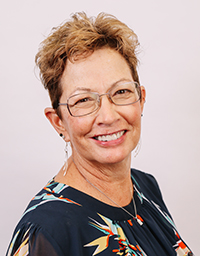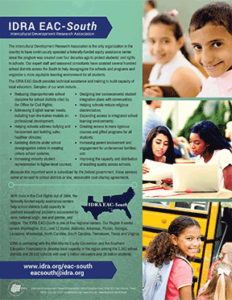• Kristin Grayson, Ph.D. • IDRA Newsletter • November-December 22016 •
 School leaders have been increasingly facing new challenges with the rapid changing demographics of their schools. Sometimes, the schools they attended as children and then taught in as teachers are no longer the same. The buildings look unchanged on the outside, but a glance inside reveals a significantly more diverse student population.
School leaders have been increasingly facing new challenges with the rapid changing demographics of their schools. Sometimes, the schools they attended as children and then taught in as teachers are no longer the same. The buildings look unchanged on the outside, but a glance inside reveals a significantly more diverse student population.
In some cases, these changes occurred gradually; in others they moved quickly as new families moved into the area to live and to work in an ever changing economy. For example, the IDRA EAC-South helps small rural districts with fewer than 1,000 students adapt to a student population that is now 40 percent English learners from multiple language groups, and we work with large urban districts that now have majority minority students with 70 percent of students being English learners from multiple language groups.
Challenges school leaders face include presenting appropriate curriculum for English learners who arrive with different cultural and linguistic backgrounds; preparing teachers to serve newcomers (under 12 months in the United States); integrating the needs of students who have had interrupted formal schooling or no schooling at all; addressing the needs of students who are refugees from war-torn areas who have experienced unspeakable trauma, as well as students who were born in the United States and have attended other schools but have never acquired proficient academic English; and adopting a social justice perspective that transcends the school vision, culture and instruction.
This article gives recommendations based on IDRA’s change model. The IDRA Quality Schools Action Framework™ is based on experience and empirical evidence that emerges from existing theories of change. The model comprises elements for assessing a school’s conditions and outcomes, for identifying leverage points for improvement, and for informing action.
The framework begins with the desired outcome: all students, including those who have entered as English learners, will graduate from high school, prepared for college and career. The model identifies leadership as one of the essential levers of change. In fact, some research finds the principal to be the most influential individual in the school for the success of programs for English learners (Reyes, 2006).
Following are recommendations for leaders of linguistically diverse schools.
Embrace the new normal and model this in your school by getting to know your EL students. Greet them and their parents using the correct pronunciation of their names. Validate their identity by treating them with respect and kindness. Don’t worry if you don’t speak their language. Learn something about their culture. Have all cultures represented in the school and have students help decorate hallway bulletin boards that inform others about their cultures, languages and home countries.
Ensure that you and your staff create a welcoming learning environment where all students feel safe and secure. In this inclusive environment, English learners should receive additional support they need while in the mainstream classroom. This can be done through the co-teaching or the push-in model of instruction (where the English teacher is in the general education classroom to aid ELs). Be aware of any bullying or harassment based on language, cultural differences, and/or immigration status and take appropriate action. If these types of issues persist among students, request help from the equity assistance center that serves your state.
Stay up to date about second language acquisition and different program models that your school can use. Make sure all teachers in the school understand the levels of language proficiency and implications for content instruction. Ideally, all staff including administrators will have state ESL certification. Be sure your school and district has its ESL plan detailed in a handbook and that all staff understand the program model.
The U.S. Department of Education has released new guidance concerning Title II funds. Use these funds to prepare, support and retain quality teachers and other administrators who are working with the schools’ most vulnerable students. Attend trainings and conferences with your staff each year to stay up-to-date on the latest research. Be a role model for teachers of a professional who is always learning and is current in the field of ESL. Yes, this might take time. But remember that English learners now represent a large percentage of your school’s population.
Set high expectations for students and staff by recognizing that each student is valuable and can achieve great results. EL students’ home language is a strength that they will use as a foundation for future knowledge and skills. For some students, their parents have risked their lives and made incredible sacrifices so that their children can have a better future. Although some students don’t speak any English yet, they still have a home language and experiences sometimes even greater than their age would predict. Help teachers deliver rigorous content classes with appropriate ESL support to prepare English learners as leaders of tomorrow.
Ensure that the school and district’s ESL and/or bilingual education program is well implemented. The three prongs of the Casteñeda vs. Pickard test for language programs are: (1) that the program is based on research, (2) that the program is implemented with fidelity, and (3) that the program achieves the intended results for students’ language proficiency and content achievement. Recall that it can take five to seven years for an English learner to become proficient in the academic English needed for success in school. Use data to inform decision making about any changes to the program implementation.
Build administrator and teacher student self-efficacy. Teachers and administrators not only need the knowledge about English learners, they also must have the will and belief that they can teach them. This self-efficacy is a complex process that is built over time within a supportive and motivating environment and where a sense of collective efficacy is established. Everyone is in this process together.
Strengthen student self-efficacy by establishing a supportive environment that acknowledges students’ identities as they learn the content and acquire English proficiency. Along with knowledge and skills, students, supported by teachers and administrators, acquire the belief in themselves that they can accomplish the difficult and challenging tasks of becoming proficient in English and succeeding in school. With this sense of self, students are better prepared to push through the challenges that they face.
Administrators play an essential role in the success of English learners in their schools. While challenging, it is also exciting to transform the school into one that helps all students succeed.
 For more information about the IDRA EAC-South or to request technical assistance, contact us at 210-444-1710 or eacsouth@idra.org. Additional resources are available online at http://www.idra.org/eac-south/
For more information about the IDRA EAC-South or to request technical assistance, contact us at 210-444-1710 or eacsouth@idra.org. Additional resources are available online at http://www.idra.org/eac-south/
funded by the U.S. Department of Education.
Resources
Avilés, N., & J.C. García. (September 2014). “An Elementary School’s STEM Success Story – IDRA Technical Assistance Empowers Teachers with Strategies to Impact Student Learning,” IDRA Newsletter (San Antonio, Texas: Intercultural Development Research Association).
Avilés, N. (March 2011). “Defining a Schoolwide College-Readiness Culture for All Students An Interview with Roland Toscano, M.S., Principal at East Central High School in San Antonio,” IDRA Newsletter (San Antonio, Texas: Intercultural Development Research Association).
Bojorquez, H. (2014). College Bound and Determined (San Antonio, Texas: Intercultural Development Research Association).
Reyes A. (2006). “Reculturing Principals as Leaders for Cultural and Linguistic Diversity.” In Téllez K., & H.C. Waxman (Eds.), Preparing Quality Educators for English Language Learners: Research, Policies, and Practices (Mahwah, NJ: Lawrence Erlbaum).
Robledo Montecel, M., & C.L. Goodman (eds). (2010). Courage to Connect – A Quality Schools Action Framework (San Antonio, Texas: Intercultural Development Research Association).
Theoharis, G., & J. O’Toole. (March 11, 2011). “Leading Inclusive ELL Social Justice Leadership for English Language Learners,” Educational Administration Quarterly.
Kristin Grayson, Ph.D., is an IDRA education associate. Comments and questions may be directed to her via email at kristin.grayson@idra.org.
[©2016, IDRA. This article originally appeared in the November-December 2016 IDRA Newsletter by the Intercultural Development Research Association. Permission to reproduce this article is granted provided the article is reprinted in its entirety and proper credit is given to IDRA and the author.]



